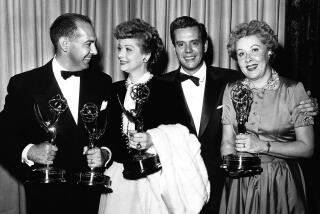Desi Arnaz, Who Loved Lucy, Dead of Cancer
- Share via
Desi Arnaz, a refugee Cuban bongo player who loved Lucy for 10 of the most entertaining and profitable years in television history, died early today of cancer.
The bandleader-executive whose business acumen doomed live television and made him and Lucille Ball multimillionaires, was 69 and died of cancer in his home in Del Mar, a San Diego suburb. His daughter, Lucie, was at his side. His son, Desi Jr., and Ball were expected later today.
His doctor, Charles Campbell, said Arnaz “died of lung cancer. It was from smoking those Cuban cigars, that’s the truth.”
Reports that Arnaz was seriously ill had circulated since 1981, when he was hospitalized for what his wife, Edith Mack Hirsch, said at the time was a flare-up of diverticulitis, an inflammation of the intestinal tract for which he had undergone four operations in 1969 and 1970. Hirsch died last year.
From Oct. 15, 1951, to Sept. 24, 1961, Arnaz was Ricky Ricardo, the forbearing spouse of a wacky wife who spent much of her time trying to convince her musician husband that she too belonged in show business.
Thousands of Reruns
Arnaz as Ricky led the band at the mythical Tropicana Club and devoted his offstage efforts trying to placate the Lucy he wanted to be only a simple housewife.
Arnaz’s broken English coupled with the comedic greatness of Ball, and complemented by their neighbors and friends, Fred and Ethel Mertz, all conspired to transform that simple plot line into a show that for 180 episodes and through thousands of reruns kept Americana glued to its TV sets.
From 1952 to 1958, the show never ranked lower than third among all programs on the air. And the ratings were never higher than on the night of Jan. 19, 1953, when Lucy Ricardo gave birth to Ricky Jr. on the air as Ball was giving birth to her second child, Desiderio Alberto Arnaz y de Acha IV, at home.
The infant’s father, Desiderio Arnaz III had come to the United States at 16, joined a Cuban combo and was soon leading his own band.
He landed a role in a Broadway show, “Too Many Girls” and met Ball, seven years his senior, when he came to Hollywood to make a film of that stage production. Within six months of their meeting they married.
Three-Camera Technique
Between Arnaz’s Army service in World War II and his band tours after the war, the couple was apart during many of the early years of their marriage.
Thus when Ball was approached about doing a TV series, she insisted that Arnaz be a part of the show. The couple also insisted that the show be filmed in front of a live audience so they could live in California rather than New York where television was being done live in 1951.
Arnaz pioneered a three-camera filming technique that is widespread today in which three cameras simultaneously filmed from different angles, with a final program combined later.
The process added $5,000 to the $19,500 weekly budget of the show, and CBS and sponsor Philip Morris agreed to put up an additional $2,000 each if Arnaz would pay the remaining $1,000.
He agreed, but only if he and his wife could own the shows. A few years later he sold them back to CBS for $4.5 million.
More to Read
The complete guide to home viewing
Get Screen Gab for everything about the TV shows and streaming movies everyone’s talking about.
You may occasionally receive promotional content from the Los Angeles Times.






